WASHINGTON, DC
November 16, 2013
STRANGER: Richard Kiel
LOCATION: Old Ebbitt Grill, 675 15th Street NW, Washington, DC
THEME: Dining with Jaws from the James Bond movies
Richard Kiel can’t hide from his fans — but he doesn’t mind.
The actor, perhaps best known for his role as the villain Jaws in two James Bond movies, has learned to live with being recognized. Where some actors stand out in public because they’re instantly recognizable, Richard literally stands out from the crowd at 7 feet and 1-and-a-half inches tall.

“I can’t just wear a hat and sunglasses and disappear,” he joked as we shared an evening meal at the Old Ebbitt Grill in Washington, DC. “But I don’t need a bodyguard. People seem to like me and I never feel endangered. I guess they’re kind of intimidated.”
It’s easy to see why. Although his towering frame was seated when I arrived at the restaurant, I still got a sense of his overwhelming presence when we shook hands, as mine was enveloped by his bear claw-like appendage. But his relaxed, deep voice and easygoing nature creates an image more like a friendly giant.
Maybe not what you’d expect from someone whose big break was the silent role of Jaws, a monstrous murderer with steel teeth that could cut through flesh and metal with ease.
But, as with many actors best known for a particular character, there’s far more to the 74-year-old’s career than being a nemesis of Roger Moore’s 007. He’s enjoyed wide-ranging roles in movies and television. Separately, he’s also heavily invested in a multi-year labor of love: a biopic of the 19th century anti-slavery crusader Cassius Clay — the man that boxer Muhammad Ali was named after before he switched to Islam.
Yet it was the role of Jaws that had brought the California resident to DC for a week, with Richard appearing at a party thrown at the International Spy Museum, which is currently hosting a Bond villains exhibit. With his wife in tow, he was spending his time seeing the sights that he hadn’t experienced on previous visits, including a tour of the U.S. Capitol — and then dinner with a stranger.
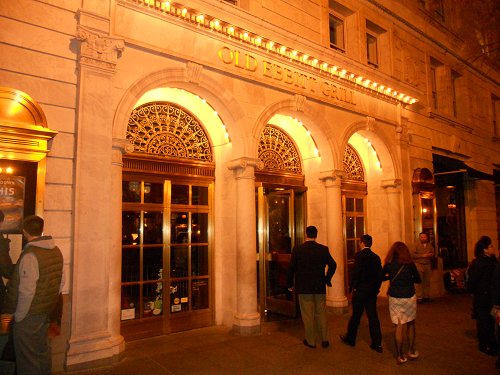
Our venue for the interview was the Old Ebbitt, the longest operating restaurant in the city, dating back to 1856, although it’s changed location from its original site. A block from the White House, it draws many tourists and federal workers, lobbyists and other politicos for decent drinks and a menu that offers a good range of restaurant standards such as pastas and sandwiches.
We started with a plate of fried calamari, served with a slightly tangy dip.

While stabbing at the mound of battered squid, Richard said that despite a life on screen and a frame that towers over others, he was a shy child growing up in Detroit, Michigan. He wasn’t unusually sized until his late teens, when he had a growth spurt.
The height advantage could have made Richard a high school basketball star, yet was “a little too bulky” to excel at that sport. Football was another option, but the coach kept trying to put Richard in offensive positions rather than the defensive role that was a more natural fit. So he spent a lot of his time sitting on the sidelines.
His father, a business owner, saw that Richard was disappointed at not getting playing time and gave his son a choice: Did he want to play football, or did he want a new car? A new car sounded pretty good to Richard, so instead of using his spare time to sit on the benches at football games, he started working for his father delivering large appliances such as dishwashers and refrigerators.
After graduating high school, Richard did a number of odd jobs and even contemplated pursuing a career as an attorney. But his father passed away in 1958 — when Richard was 19 — and a recession caused the family business to close, putting pressure on Richard to find work.
He needed the money not only to live but also for clothing, because back then there were no “big and tall” shops catering to the sizable in width or height. A specially tailored sports coat could set Richard back for the same price tag as a decent used car. And the only way he could sleep comfortably was in a king bed, a luxury at the time. It’s expensive being tall.
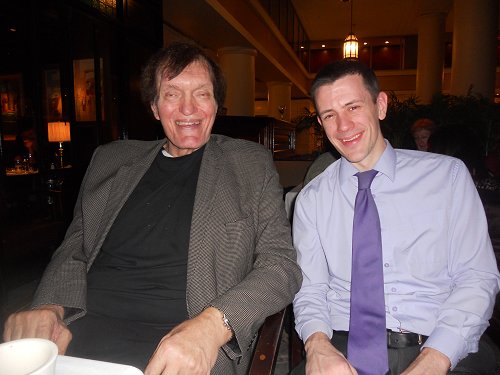
Realizing the high cost of being big, Richard’s aunt pitched an idea: Why not become an actor? It was a suggestion out of nowhere, but one he liked.
“I thought it was a good idea. I could use my size to make the money I needed to buy sports coats, king-size beds, and cars big enough to fit in,” Richard said.
So he moved to Hollywood to try a career in acting.
Despite his adolescent shyness, he found that the highly public business of acting was an enjoyable profession. “I found that as an actor that if you can get behind a character then you can have fun with it and not be yourself — you kind of hide behind the character.”
Some aspiring actors might pay thousands for years in an arts college to hone their skills, but Richard said that working for his salesman father had taught him how to take on any persona and be able to project confidence. “He also taught me two important things. One, the harder you work, the luckier you get. And two, nothing ventured, nothing gained. Sometimes you have to invest in yourself,” Richard said.
Working off that advice, Richard would place advertisements in the Hollywood Reporter and Variety to promote some of the bigger roles he would score. And his resume was starting to bulk up with small roles in TV shows such as The Twilight Zone and Lassie.
Richard needed an agent, and had a hard time getting one.
He obtained an A-to-Z list of agents from the Screen Actors Guild (SAG), the union representing film and television performers, and started working his way through the list. He finally ended up being represented by Herman Zimmerman — “with a ‘z,’ so you can see I didn’t give up,” said Richard, breaking into a smile he showed throughout dinner.
“He was not too enthusiastic to take me on, but he was the least pessimistic. He said, ‘If you still want to be an actor in six months, come back and see me.”
During those six months Richard scored some larger roles and a vital SAG members’ card, then went back to Mr. Zimmerman’s office. “Then I said, ‘Do you want to be my agent or not?” Zimmerman took on his new client, and the two were together many years.
The conversation was leading toward Richard’s big break — his role as Jaws — when our waiter cut us off with the arrival of our main courses.
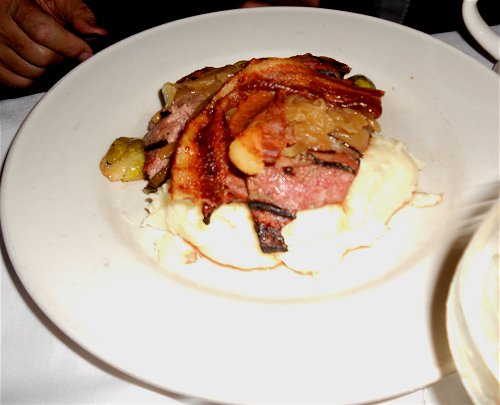
Richard opted for the grilled calf’s liver with caramelized onions, bacon, mashed potatoes and Brussels sprouts. As he tucked into the impressive-looking mound of food, he said he was reminded of a dish of veal liver that he’d enjoyed during a visit to Scotland.
I had fish and chips, nostalgic for a meal from my home country of England.
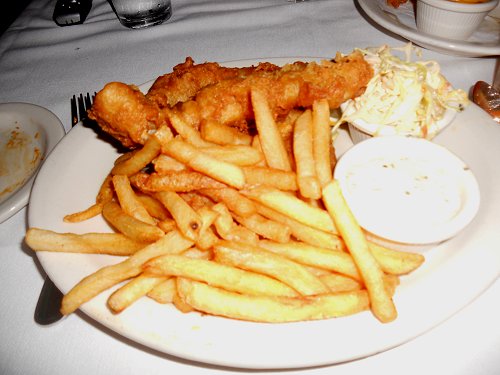
I’d toyed with something more adventurous but then remembered someone telling me once that Old Ebbitt has good fish dishes. As a Brit, I’ve struggled to find decent fish and chips in the United States since moving here in 2004. This version wasn’t the greatest, but the batter on the fish was well done — crisp and not too fatty or salty. And I can’t fault the huge size of the portion.
While we ate, Richard talked about his breakthrough film performance as a James Bond bad guy.
As a silent henchman to the main villain Karl Stromberg in the 1977 Bond movie The Spy Who Loved Me, Jaws found strong fan support because of his mix of menace and humor. Unlike most straightforward villains, Jaws was superhuman in strength and would earn a chuckle as he emerged relatively unscathed from catastrophes such as a pyramid collapsing on top of him, or getting kicked out of a moving train.
That fan affection meant that Jaws was revived in the next 007 outing, 1979’s Moonraker, in which the villain — spoiler alert! — helps Bond save the day. Jaws even found time to make a love interest, and to finish with a few lines of dialogue that are better delivered on screen than in print.
“After 17 years of doing all kind of movies and television, I became an overnight success with the Bond movies,” said Richard, smiling.
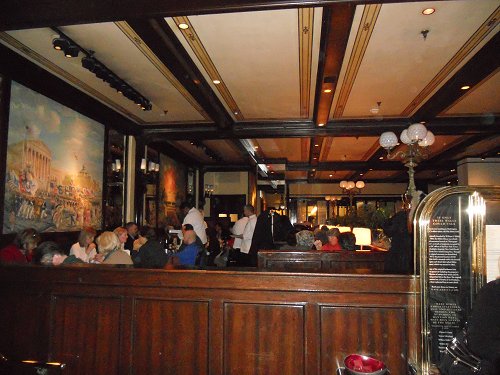
The role of Jaws came about after a few higher-profile roles, including Samson in the 1974 prison football movie The Longest Yard. That performance helped secure Richard the role of Moose Moran in the short-lived (1975-6) Wild West show Barbary Coast.
He was spotted from that show and recommended to meet with Bond producer Albert “Cubby” Broccoli, who had already interviewed David Prowse for the role of Jaws. Prowse was the man in the Darth Vader costume in Star Wars whose voice was ultimately replaced with that of James Earl Jones.
Heading to the meeting with Broccoli, Richard had his reservations as he saw Jaws as a monster and he’d been trying to move away from monster roles. “But I loved James Bond movies and a little voice in my head said, ‘Figure out how to make it work.’”
So he pitched this to Broccoli: “I said whoever you hire, you really need an actor. A guy who kills people with his teeth sounds exciting, but could be over the top. But I would want to play him with humorous qualities, with perseverance, frustration.” Richard said he could use his pantomime skills learned from a silent role as a cave man in the 1962 movie Eegah! — the tale of teenagers who find the cave man, who ends up going on a rampage.
Broccoli was sold. Richard was Jaws. Fame was assured.
Following the Bond movies, Richard has enjoyed a steady stream of work that has taken him around the world — giving him, his wife and four children a great chance to travel — and also secured a fan-base of 007 aficionados. He’s often in demand for appearances at Bond-themed events, including the Spy Museum party in Washington and other spots across the globe.
Although older generations would recognize him as Jaws, Richard said that younger people also come up to him for photographs and autographs based off his role as Mr. Larson in Adam Sandler’s 1996 golf comedy movie Happy Gilmore. “A lot of people remember me from that.”
Other recent work includes one he’d never be physically recognized for — his role as Vlad in the 2010 Disney animated movie Tangled. Richard said it was interesting to do the voiceover performance because decades ago, actors would see the completed animation and try to sync their acting to it, whereas for Tangled he acted out his lines with direction before the animation was completed.
Upcoming roles include for the movie Overlord, in which he plays a good guy: a wheelchair-bound billionaire trying to save women and children from aliens who killed his daughter. The character uses his wealth to build a souped-up wheelchair with built-in machine gun and rocket launcher, and Richard said the role gives him an opportunity for “oodles of dialogue and lots of humorous stuff.”
Richard said he’s content to keep doing what he’s doing. As he made clear at the start of dinner, he’s accepted the inevitable recognition and lack of privacy.
Some questions he gets asked by interviewers can be redundant, he said, and before I could make that misstep he offered up examples, such as whether the steel teeth hurt to wear? (they did, they were nauseating); what’s Roger Moore like? (a nice guy, the two are close friends to this day); and who’s your favorite Bond? (He didn’t volunteer that answer).
But he’s learned to put a smile on his face and answer every question with patience and charm, judging off our two hours together, which wrapped up with us splitting a slice of pecan pie.
My sweet tooth means I’ll always give the upper hand to anything that’s loaded with sugar, but bias notwithstanding this was an excellent dessert. Thick crust, gooey but not overwhelming filling, and sufficiently crunchy pecans littering the top of the pie. Thumbs up for the third act of the meal.
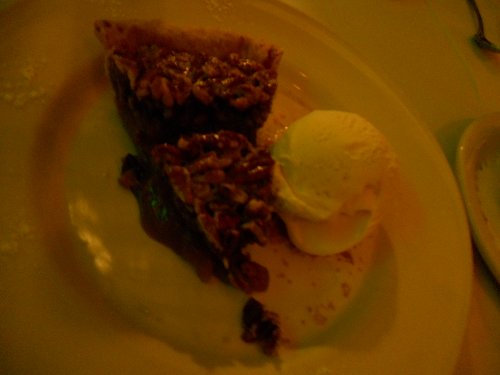
The questioning on my end ceased as I diverted my attention from Richard to the moreish pie, so he took the opportunity to tell me about another labor of love beyond acting.
Over the course of 25 years he researched the life of emancipationist Cassius Clay, who Richard said is an overlooked anti-slavery crusader from the 1800s. It’s not his only book — he also wrote his autobiography called Making It Big In The Movies, which made it easy to obtain a title for this interview — but it’s one he’s emotionally invested in.
Richard was inspired to learn more about Clay through his wife, Diane. She’s from Georgia, a state in the South where Richard said there is a stereotype of racism and a past in which most everyone owned slaves. “My wife doesn’t have a racist bone in her body,” said Richard. “I found this to be rather interesting that not all the people in the South were like what they were depicted to be.”
Around a quarter-century ago, a friend showed Richard a documentary he was working on, which first alerted him to Clay. Intrigued, he did more research and this built until Richard realized that the drama of Clay’s life was more than enough material for a book.
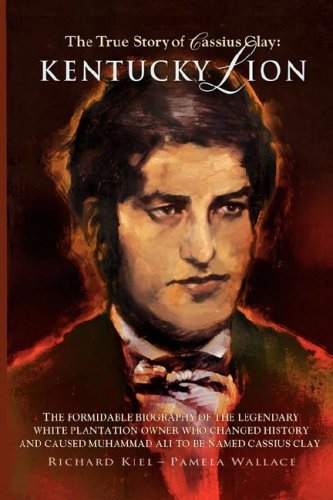
He worked with screenwriter Pamela Wallace — who won a Best Screenplay Oscar for the 1985 Harrison Ford movie Witness — to transfer more than 20 years of notes, visits to museums, newspaper articles and more into Kentucky Lion: The True Story of Cassius Clay. The book, of which he kindly gave me a copy, walks readers through the life and times of Clay, including intrigue such as assassination attempts on the man’s life.
Richard said he’s pleased with how the book turned out, and believes that it offers an important insight into a figure that American history hasn’t paid much attention, although Clay gained some notability as it was the original name given to Muhammad Ali. With the book published, Richard is shopping it around as potential grist for a television miniseries or movie based on what he described as Clay’s dramatic life.
As dinner was wrapping up, I realized I hadn’t taken the typical at-the-table photos for the article, and moved next to Richard to get positioned for a few snaps.
After one or two standard sit-and-smile poses seen above, that’s when Richard once again embodied the Jaws persona, lunging toward me with his massive hands outstretched, clasping my head at top and bottom like a vice, and grinning for the camera.
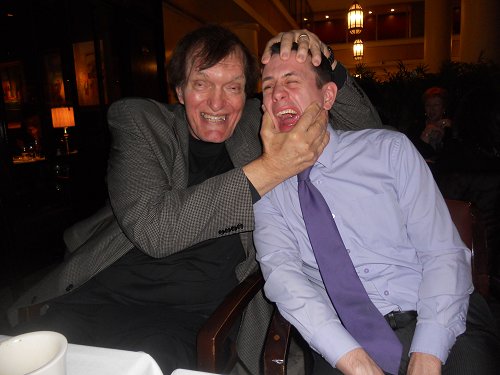
When the glare of the flash died down and Richard released me from his grasp, I was thankful that Jaws was just a character and Richard was only acting. And his smooth transition to Richard the historian, with a wealth of stories about Cassius Clay, gave a fuller picture of the man known as Jaws.
But witnessing his ability to drop into character so quickly, it was clear how he was able to make it big in the movies.